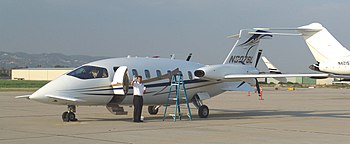Piaggio P.180 Avanti
The Piaggio P.180 Avanti is a twin-engine business aircraft produced by Piaggio Aero. It seats up to nine passengers in a generous pressurized cabin, and may be flown by one or two pilots.
Configuration
The Avanti has turboprop engines in a pusher configuration, placed on a mid-fuselage, high aspect ratio wing. The wing is located very far aft, behind the cabin, and the highly unconventional design also features a T-tail and a fixed canard foreplane. This arrangement allows all three wing surfaces to provide lift in the upwards direction, as opposed to a conventional configuration, where the horizontal stabilizer creates a downward force, requiring the main wing to produce more lift to balance this force, and thus increasing induced drag. The Avanti's aerodynamics and turboprop engines result in an extremely efficient aircraft.
Distinctive design features include a non-constant cross section cabin, the shape of which is a figure of revolution based on a NACA airfoil section. The mid cabin is therefore considerably wider than the cockpit, and the entire cabin sits ahead of the main wing spar. The wing and canard airfoils are custom sections designed by Dr. Jerry Gregorek of Ohio State University to achieve 50% laminar flow at cruise.
History
The P.180 was wind tunnel tested in Italy and the U.S. in 1980 and 1981. A collaboration with Learjet to develop the aircraft was begun in 1982, ending in 1986, when the prototype first flew. U.S. certification was obtained in 1990. The first 12 fuselages were built in Wichita, with H & H Parts and Plessey Midwest, then flown to Italy for assembly. Avanti Aviation Wichita ran out of money in 1994; the project languished until a group of investors led by Piero Ferrari became involved in 1998. The 100th aircraft was delivered in October 2005.
The P.180 makes a distinctive square wave noise when passing overhead, similar to the Beech Starship, due to wing wake and engine exhaust effects on the propeller. It is relatively noisy compared to most turboprop aircraft.
A new Avanti II obtained European and US certification in November 2005. Six months later, seventy planes were already ordered (36 by Avantair).
Trivia
The P.180 appears in Michael Mann's Miami Vice (2006) as one of the business planes used by one of the characters. The two main characters fly an Adam A500, making the film a showcase of unconventional airplane design.
Specifications (P.180)
| Manufacturer: | Piaggio |
| Crew | one or two pilots |
| Capacity | up to nine passenger |
| Cabin dimensions | 1.75 m (5 ft 6 in) high, 1.85 m (5 ft 10 in) wide, 4.45 m (14 ft 6 in) long |
| Payload main | 907 kg |
| Payload alt | 2,000 lb |
| Length main | 14.40 m |
| Length alt | 47 ft 2 in |
| Span main | 14.03 m |
| Span alt | 46 ft |
| Height main | 13 ft 1 in |
| Height alt | 3.98 m |
| Area main | 16 m² |
| Area alt | 172.2 ft² |
| Empty weight main | 3,400 kg |
| Empty weight alt | 7,500 lb |
| Loaded weight main | |
| Loaded weight alt | |
| Useful load main | 1,862 kg |
| Useful load alt | 4,105 lb |
| Max takeoff weight main | 5,262 kg |
| Max takeoff weight alt | 11,601 lb |
| Engine (prop) | Pratt & Whitney Canada PT6A-66 |
| Type of prop | turboprops |
| Number of props | 2 |
| Power main | 634 kW |
| Power alt | 850 shp |
| Max speed main | 737 km/h |
| Max speed alt | 398 kt |
| Cruise speed main | 644 km/h |
| Cruise speed alt | 348 kt |
| Range main | 2,595 km |
| Range alt | 1,400 nm |
| Range more | with one pilot, six passengers and IFR reserves |
| Ceiling main | 12,500 m |
| Ceiling alt | 41,000 ft |
| Climb rate main | 14.98 m/s |
| Climb rate alt | 2,950 ft/min |
| Loading main | 327.4 kg/m² |
| Loading alt | 67.07 lb/ft² |
| Power/mass main | 4.13 kg/kW |
| Power/mass alt | 6.79 lb/hp |
